如何使用DPS通過對稱密鑰進行設備組注冊?-創新互聯
圖文講解:
1. 在DPS添加組注冊:
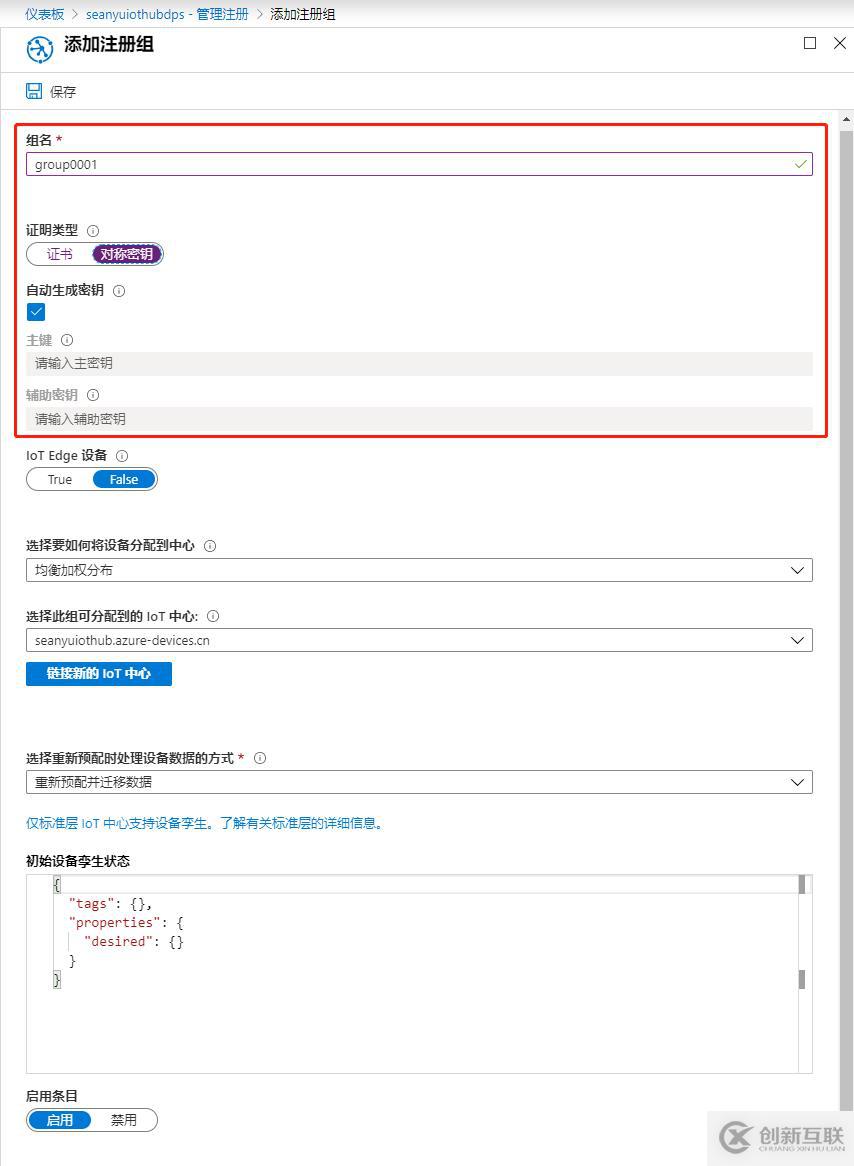
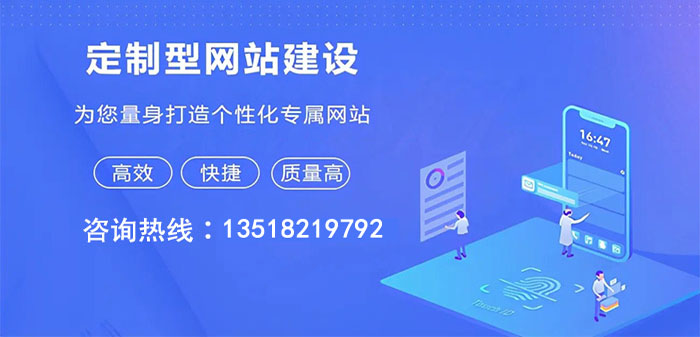
注意:組注冊中,沒有注冊ID的概念,也沒有Device ID的概念。
機制
有三種:x509證書,對稱密鑰
在本例中,我們使用對稱密鑰方式以便我們快速理解和驗證組注冊的業務邏輯;
密鑰我們采用自動生成,當然也可以手動輸入符合要求的自定義密鑰;
注意:本文中使用對稱密鑰方式做演示,后續章節介紹X509證書的方式,證書也是推薦的海量設備方案中應用的方案。
如何分配設備到中心
最低延遲:將設備預配到具有最低延遲的 IoT 中心,注意最低延遲不是指地理位置,例如中國北部的設備根據網絡情況可能出現分配到中國東部IoT Hub的情況。
均勻加權分發(默認):鏈接的 IoT 中心等可能地獲得預配到它們的設備。 此設置為默認設置。 如果只將設備預配到一個 IoT 中心,則可以保留此設置。
通過注冊列表進行靜態配置:注冊列表中所需 IoT 中心的規范優先于設備預配服務級別的分配策略。
使用Azure Function(自定義):該方案可以使用自定義邏輯判斷分發到哪個IoT Hub。
在本例中,我們只配置了一個IoT Hub,因此采用默認的均勻加權即可。
初始設備孿生狀態
例如可以設置版本號為 1.11,會按照device twin的邏輯進行版本升級;
添加之后的狀態為:
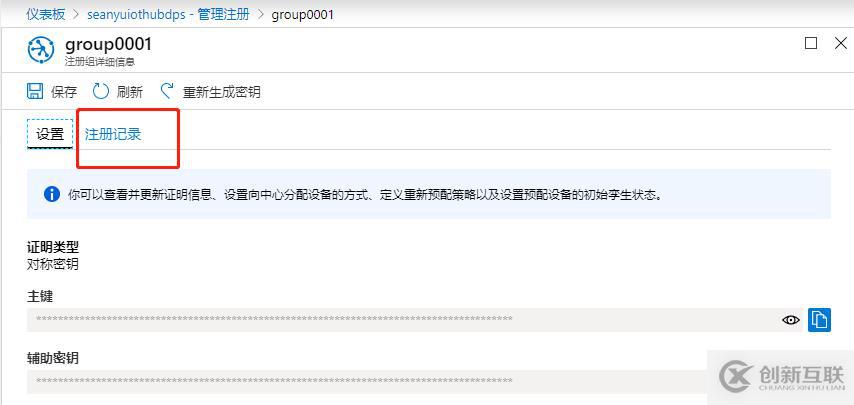
注冊記錄為空:
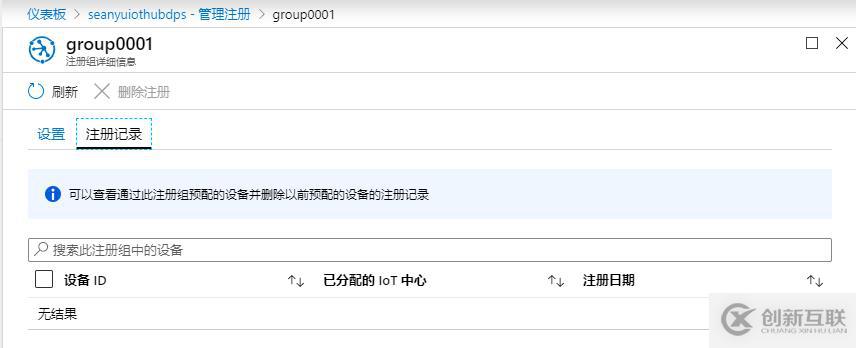
2.準備示例代碼
項目中使用的示例代碼,https://codeload.github.com/Azure-Samples/azure-iot-samples-csharp/zip/master
關鍵處請參加如下代碼中的中文注釋:
// Copyright (c) Microsoft. All rights reserved.// Licensed under the MIT license. See LICENSE file in the project root for full license information.using Microsoft.Azure.Devices.Provisioning.Client;using Microsoft.Azure.Devices.Provisioning.Client.Samples;using Microsoft.Azure.Devices.Provisioning.Client.Transport;using Microsoft.Azure.Devices.Shared;using System;using System.Security.Cryptography;using System.Text;namespace SymmetricKeySample{ class Program { // The Provisioning Hub IDScope. // For this sample either: // - pass this value as a command-prompt argument // - set the DPS_IDSCOPE environment variable // - create a launchSettings.json (see launchSettings.json.template) containing the variable //private static string s_idScope = Environment.GetEnvironmentVariable("DPS_IDSCOPE"); private static string s_idScope = "此處需要修改成dps的ID"; // In your Device Provisioning Service please go to "Manage enrollments" and select "Individual Enrollments". // Select "Add individual enrollment" then fill in the following: // Mechanism: Symmetric Key // Auto-generate keys should be checked // DeviceID: iothubSymmetricKeydevice1 // Symmetric Keys may also be used for enrollment groups. // In your Device Provisioning Service please go to "Manage enrollments" and select "Enrollment Groups". // Select "Add enrollment group" then fill in the following: // Group name: <your group name> // Attestation Type: Symmetric Key // Auto-generate keys should be checked // You may also change other enrollment group parameters according to your needs //private const string GlobalDeviceEndpoint = "global.azure-devices-provisioning.net"; //此處應該改成中國的終結點.CN結尾 private const string GlobalDeviceEndpoint = "global.azure-devices-provisioning.cn"; //These are the two keys that belong to your enrollment group. // Leave them blank if you want to try this sample for an individual enrollment instead private const string enrollmentGroupPrimaryKey = "僅當使用組注冊時,必須填寫此值"; private const string enrollmentGroupSecondaryKey = "僅當使用組注冊時,必須填寫此值"; //registration id for enrollment groups can be chosen arbitrarily and do not require any portal setup. //The chosen value will become the provisioned device's device id. // //registration id for individual enrollments must be retrieved from the portal and will be unrelated to the provioned //device's device id // //This field is mandatory to provide for this sample private static string registrationId = "對于組注冊,此處為待注冊的設備DeviceID,通常填寫諸如MAC地址等唯一值"; //These are the two keys that belong to your individual enrollment. // Leave them blank if you want to try this sample for an individual enrollment instead private const string individualEnrollmentPrimaryKey = ""; private const string individualEnrollmentSecondaryKey = ""; public static int Main(string[] args) { if (string.IsNullOrWhiteSpace(s_idScope) && (args.Length > 0)) { s_idScope = args[0]; } if (string.IsNullOrWhiteSpace(s_idScope)) { Console.WriteLine("ProvisioningDeviceClientSymmetricKey <IDScope>"); return 1; } string primaryKey = ""; string secondaryKey = ""; if (!String.IsNullOrEmpty(registrationId) && !String.IsNullOrEmpty(enrollmentGroupPrimaryKey) && !String.IsNullOrEmpty(enrollmentGroupSecondaryKey)) { //Group enrollment flow, the primary and secondary keys are derived from the enrollment group keys and from the desired registration id //注意,此處的primaryKey和secondryKey即IoT Hub中新增Device 的primaryKey和secondryKey primaryKey = ComputeDerivedSymmetricKey(Convert.FromBase64String(enrollmentGroupPrimaryKey), registrationId); secondaryKey = ComputeDerivedSymmetricKey(Convert.FromBase64String(enrollmentGroupSecondaryKey), registrationId); } else if (!String.IsNullOrEmpty(registrationId) && !String.IsNullOrEmpty(individualEnrollmentPrimaryKey) && !String.IsNullOrEmpty(individualEnrollmentSecondaryKey)) { //Individual enrollment flow, the primary and secondary keys are the same as the individual enrollment keys primaryKey = individualEnrollmentPrimaryKey; secondaryKey = individualEnrollmentSecondaryKey; } else { Console.WriteLine("Invalid configuration provided, must provide group enrollment keys or individual enrollment keys"); return -1; } using (var security = new SecurityProviderSymmetricKey(registrationId, primaryKey, secondaryKey)) // Select one of the available transports: // To optimize for size, reference only the protocols used by your application. using (var transport = new ProvisioningTransportHandlerAmqp(TransportFallbackType.TcpOnly)) // using (var transport = new ProvisioningTransportHandlerHttp()) // using (var transport = new ProvisioningTransportHandlerMqtt(TransportFallbackType.TcpOnly)) // using (var transport = new ProvisioningTransportHandlerMqtt(TransportFallbackType.WebSocketOnly)) { ProvisioningDeviceClient provClient = ProvisioningDeviceClient.Create(GlobalDeviceEndpoint, s_idScope, security, transport); var sample = new ProvisioningDeviceClientSample(provClient, security); sample.RunSampleAsync().GetAwaiter().GetResult(); } Console.WriteLine("Enter any key to exit"); Console.ReadLine(); return 0; } /// <summary> /// Generate the derived symmetric key for the provisioned device from the enrollment group symmetric key used in attestation /// </summary> /// <param name="masterKey">Symmetric key enrollment group primary/secondary key value</param> /// <param name="registrationId">the registration id to create</param> /// <returns>the primary/secondary key for the member of the enrollment group</returns> public static string ComputeDerivedSymmetricKey(byte[] masterKey, string registrationId) { using (var hmac = new HMACSHA256(masterKey)) { return Convert.ToBase64String(hmac.ComputeHash(Encoding.UTF8.GetBytes(registrationId))); } } } }3.運行程序,得到分配的IoT Hub名稱以及DeviceID
設備側程序可以得到IoT Hub的名稱,設備的ID,加上代碼里的key,則具備了連接IoT Hub的所有參數,此時可以直接連接到IoT Hub。

此時,可以在組注冊中的注冊列表中看到對應的注冊記錄:
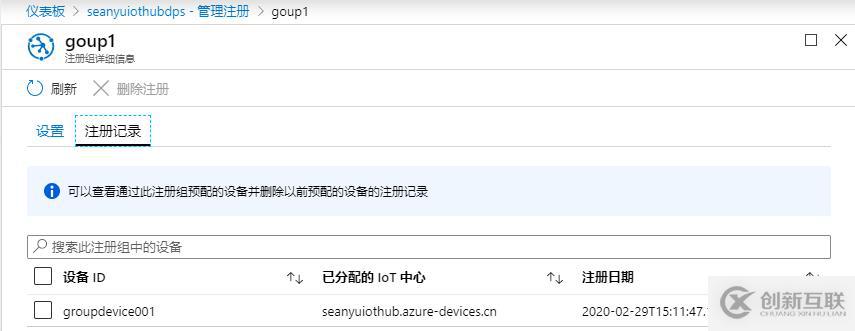
此時,在IoT Hub中能夠看到由DPS注冊過來的Device:
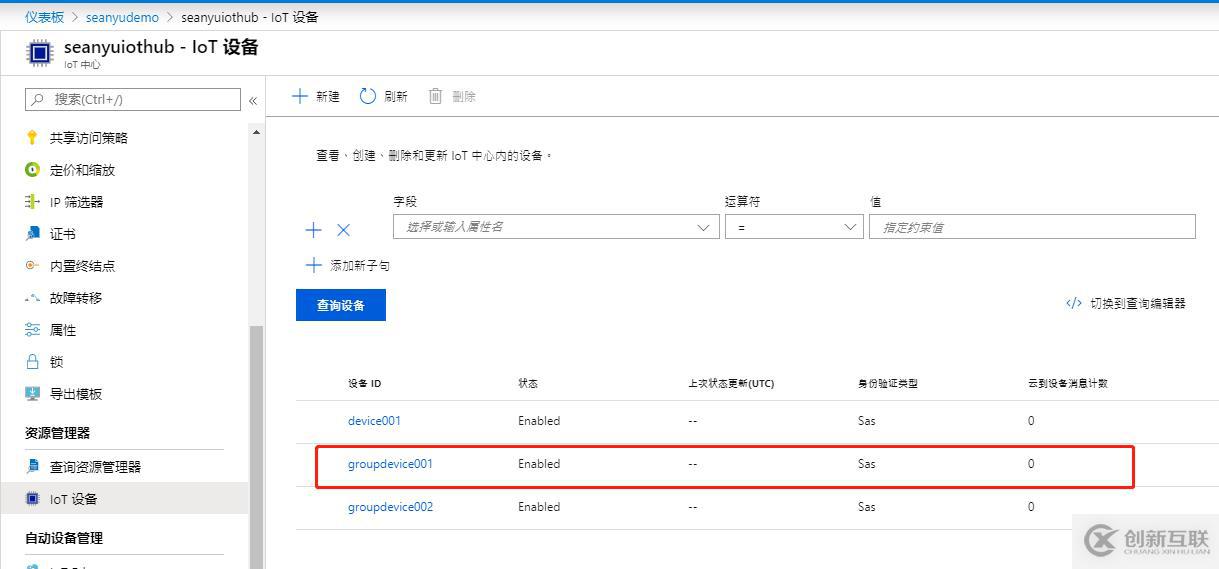
將代碼中的 private static string registrationId = "對于組注冊,此處為待注冊的設備DeviceID,通常填寫諸如MAC地址等唯一值"; 替換,可以通過DPS的這個組注冊添加多臺設備到IoT Hub中:
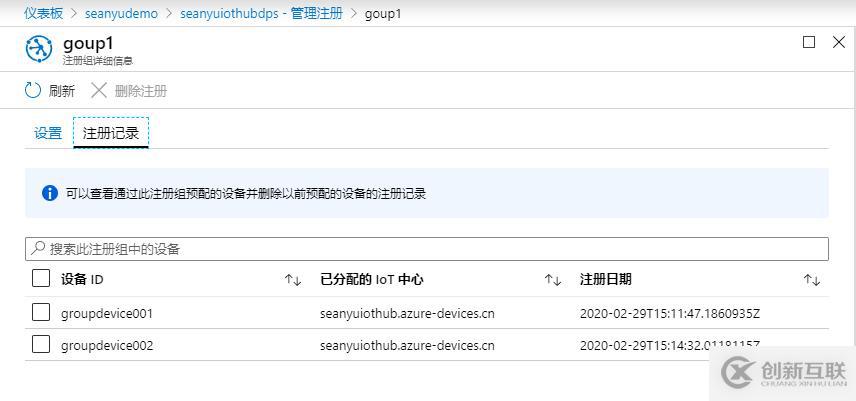
另外有需要云服務器可以了解下創新互聯cdcxhl.cn,海內外云服務器15元起步,三天無理由+7*72小時售后在線,公司持有idc許可證,提供“云服務器、裸金屬服務器、高防服務器、香港服務器、美國服務器、虛擬主機、免備案服務器”等云主機租用服務以及企業上云的綜合解決方案,具有“安全穩定、簡單易用、服務可用性高、性價比高”等特點與優勢,專為企業上云打造定制,能夠滿足用戶豐富、多元化的應用場景需求。
網頁名稱:如何使用DPS通過對稱密鑰進行設備組注冊?-創新互聯
本文路徑:http://vcdvsql.cn/article46/pjdeg.html
成都網站建設公司_創新互聯,為您提供網站制作、網站策劃、品牌網站設計、定制網站、建站公司、動態網站
聲明:本網站發布的內容(圖片、視頻和文字)以用戶投稿、用戶轉載內容為主,如果涉及侵權請盡快告知,我們將會在第一時間刪除。文章觀點不代表本網站立場,如需處理請聯系客服。電話:028-86922220;郵箱:631063699@qq.com。內容未經允許不得轉載,或轉載時需注明來源: 創新互聯

- 樂山網站建設-當前我國外貿型企業英文網站營銷的問題 2021-11-29
- 做了關鍵詞優化,排名依然沒有提升名 2016-04-02
- 軟文推廣怎么寫能被百度新聞收錄? 2016-01-27
- 大型網站的搜索引擎優化SEO營銷計劃 2013-05-19
- 網站營銷干貨_內容營銷的法則 2021-01-22
- 搜索引擎優化的視覺照片和圖形如何排名 2015-01-05
- 網站優化:網站為什么不收錄? 2016-11-04
- 網站排名優化的誤區 2013-12-26
- SEO關鍵詞優化的實際方案有哪些? 2015-03-24
- 微信公眾號進展一般,應該怎么營銷? 2015-09-06
- 網站營銷什么是反向鏈接? 2014-12-09
- 網站做百度優化過程中收錄急劇減少應該怎么排查原因? 2014-11-10